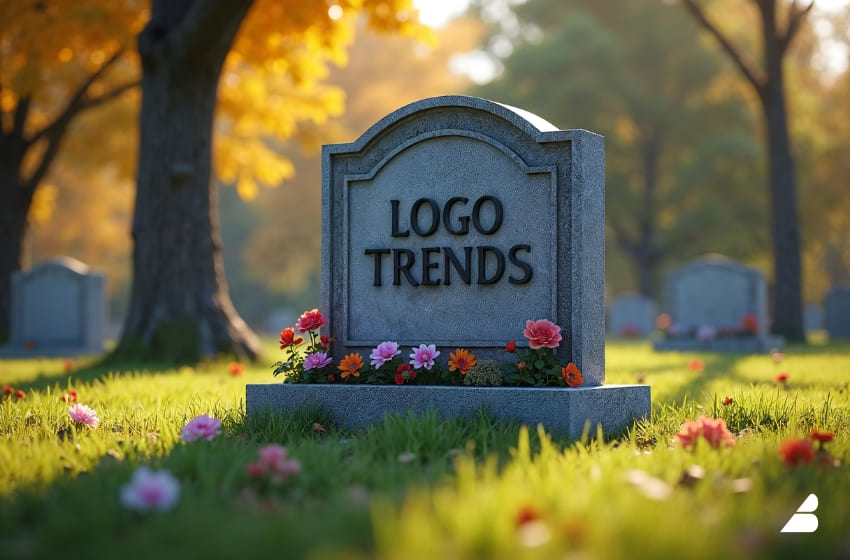
Logo trends come and go, shaping the ever-evolving world of brand identity. Companies strive to create a visual identity that stands the test of time. Yet, not all design choices are successful. Some trends rise quickly, only to fade just as fast. Certain logo trends that died should remain in the past, as they often failed to resonate with audiences or became outdated too rapidly.
One example includes overly intricate designs that posed challenges in readability and adaptability. Logos once filled with complex details are now being seen as impractical. They struggle to maintain impact across different mediums and sizes. Instead, companies are opting for cleaner and more versatile designs.
Another trend that has faded involves the excessive use of gradients and gloss, which once seemed modern but quickly lost their appeal. As digital platforms take precedence, simpler and flat designs are proving more effective. These designs offer clarity and adaptability, ensuring brands communicate their message effectively in today’s fast-paced, digital-first environment.
The Evolution of Logos in Branding
Logos have gone through significant changes, shaping how brands present themselves. As digital platforms rise, design trends focus on simplicity and minimalism to capture attention and adapt to new environments.
The Rise and Fall of Logos in the Digital Age
In the digital age, logos have transformed to meet new demands. Initially, logos were designed for print, which allowed for intricate and detailed designs. With the internet’s emergence, the need for easily recognizable logos grew.
Logos had to be versatile, working across websites, social media, and mobile apps. This shift led to a rise in using flat design, which emphasized clarity and function over ornamentation. As a result, some iconic logos became streamlined to maintain brand identity while enhancing readability on small screens.
Some brands failed to adapt, leading to decreased recognition. The digital world favored logos that were memorable and adaptable, discarding those that clung to outdated styles. This period demonstrated the importance of evolving with technology to maintain branding effectiveness.
From Complexity to Simplicity
The movement from complex to simple logos reflects a broader trend in branding. With minimalism gaining traction, brands discovered that less is often more.
Simple logos use clean lines, bold shapes, and limited colors. This style is not just about aesthetics but functionality. A simple logo is easily recognizable and can leave a lasting impression.
Complexity in logos can confuse and detract from the brand’s message. By stripping away unnecessary elements, brands enhance the essence of what they represent. As an outcome, consumers find it easier to identify and connect with brands using simple, minimalist logos.
This shift underscores the modern approach to branding, emphasizing clarity, recognition, and durability in a fast-paced digital environment.
Logo Trends That Died
In the world of design, trends can dominate the scene only to fade away later as creativity and practicality evolve. For logo design, certain patterns like the heavy use of gradients, overly complex negative space, and intricate wordmarks eventually lost their appeal, giving way to a more streamlined aesthetic.
The Overuse of Gradients and How Simplicity Prevailed
Gradients were once a go-to element in logo design. Designers loved them for adding depth and dimension. Yet, what began as an innovative technique became overused. Logos filled with vibrant gradients were often difficult to reproduce in print, causing practical issues for companies. As digital media became more prominent, simplicity became essential.
Gradients began to be seen as busy and distracting. Consumers and designers alike welcomed a shift toward flat designs and minimalism. This change made logos more adaptable across different platforms, ensuring they remained recognizable regardless of size or medium. The move to simpler designs emphasized functionality and clarity, which resonated well with audiences.
When Negative Space Became Too Cryptic
Negative space is the use of empty space around design elements to create another image or shape. It began as a clever way to engage viewers, sparking interest and double-takes. However, this technique was pushed to its limits. Some logos became so cryptic that the intended message was lost on the audience.
Designs went from being clever to complex puzzles that only a few could decipher. The trend’s decline came when brands realized the importance of clear communication over cleverness. As a result, logos adopted clearer designs where negative space is used sparingly and effectively, supporting rather than overshadowing the primary logo message.
The Decline of Intricate Wordmarks
Intricate wordmarks featured detailed typography. They appeared elegant and bespoke at first glance. However, these designs often lacked flexibility. Complex fonts could be hard to read, especially in smaller sizes or from a distance. In response, brands shifted to clean, modern fonts that enhanced readability and overall impact.
This shift aligned with the rise of digital platforms, where clarity and legibility are crucial. Simple wordmarks could maintain consistency across various digital and print materials, helping brands establish a strong, unified image. The streamlined approach to typography reflected broader design trends, emphasizing efficiency and minimalism over ornamental complexity.
Logo Redesigns: The Good, The Bad, and The Unnecessary
Logo redesigns can either enhance brand recognition or confuse loyal customers. A good redesign will maintain the core identity of a brand like Nike, while bad changes may lose touch with what made a brand unique. Some redesigns chase trends without substance, ultimately failing to resonate with their audience.
Rebranding for Relevance Versus Trend-Hopping
Rebranding can make a brand feel fresh and relevant if executed with purpose. For instance, when a company updates its logo to reflect modern aesthetics or new brand values, it helps maintain customer engagement. Brands like Supreme have managed to balance relevance with their strong identity, keeping their core essence intact.
On the other hand, trend-hopping without careful consideration can lead to a loss of brand loyalty. Designs that shift abruptly may alienate long-time fans and confuse newer audiences. The key is to differentiate thoughtful rebranding from unnecessary changes that follow fleeting trends. Consistency in visual identity is crucial in preserving brand recognition over time.
Iconic Logos That Lost Their Identity
Some logos, like those of Gap in 2010, experienced backlash due to drastic changes that stripped away core visual elements. This underscores the importance of not losing an iconic design’s essence during redesign. Maintaining key elements reinforces brand trust and loyalty.
Comparatively, Nike demonstrates how to evolve its logo without losing identity. Subtle adjustments were made over time to reflect its growth while retaining its iconic swoosh. Striking a balance between innovation and identity ensures that logos remain memorable and impactful. Brands should consider the long-term implications of redesigns to maintain their valuable connection with audiences.
The Future of Logo Design and Branding
The world of logo design is continuously evolving. Designers are now focusing on emerging trends that emphasize authenticity and adaptability in brand identity. These aspects are shaping how brands are perceived and remain relevant.
Emerging Trends in Logo and Brand Identity
New trends in logo design are marked by simplicity and minimalism. Designers are moving towards clean lines and bold shapes. These elements ensure logos are memorable and easily recognizable. Dynamic design is another trend gaining traction, allowing logos to adapt across various platforms and screen sizes.
Custom typography is also popular. Unique fonts help brands stand out and can convey specific brand identities. Furthermore, logos are increasingly featuring flat, two-dimensional designs, eliminating unnecessary complexity and focusing on essential elements to communicate a brand’s message effectively.
Incorporating Authenticity and Adaptability
Authenticity is key in modern logo design. Consumers seek genuine connections with brands, and logos that reflect brand values are more effective. This connection is often created through using colors and symbols that resonate with the target audience.
Adaptability in logos means versatility across different media. With digital platforms constantly evolving, logos must function in various contexts while maintaining their core identity. This includes responsive design, where logos adjust and remain recognizable on both large screens and mobile devices.
Finally, a focus on sustainability is becoming increasingly important. Brands are choosing eco-friendly design practices. This includes using digital instead of physical print methods and selecting colors and materials that support environmental initiatives.




